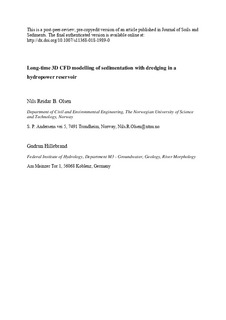Long-time 3D CFD modelling of sedimentation with dredging in a hydropower reservoir
Journal article, Peer reviewed
Accepted version

Åpne
Permanent lenke
http://hdl.handle.net/11250/2593063Utgivelsesdato
2018Metadata
Vis full innførselSamlinger
Sammendrag
The purpose of the current study was to present a 3D CFD model that can be used to predict long-term (11 years) bed changes in a reservoir due to sedimentation and dredging. And that this can be done with a reasonable computational time (18 hours) on a desktop computer. The numerical model solved the Navier-Stokes equations on a 3D non-orthogonal unstructured grid to find the water velocities and turbulence. The convection-diffusion equation for suspended sediment transport was solved to find the sediment deposition pattern. Bed changes were computed and used to adjust the grid over time. Thereby, bed elevations over time were computed. The effect of dreding was also included in the model, and how this affected the bed elevation changes. The main feature of the numerical model enabling a reasonable computational time was implicit numerical methods giving the possibility to use long time steps. The results were compared with annually measured bed elevation changes in the reservoir over 11 years, this gives 11 figures of bed elevation changes, due to sedimentation and dredging. Comparing the annually computed and measured bed changes, there was a fair agreement for most of the years. The match was not perfect, but the main deposition patterns were reproduced. The amount of sediments removed in three dredging campaigns were also computed numerically and compared with the measurements. Parameter tests were done for the grid size, fall velocity of the sediments, cohesion and sediment transport formula. The deviation was less than 16 % for all these four parameters. The 3D CFD numerical model was able to compute water flow, sediment transport and bed elevation changes in a hydropower reservoir over a time period of 11 years. Field measurements showed reasonable agreement with the computed bed elevation changes. The results were most sensitive to the sediment particle fall velocity and cohesion of the bed material. Long-time 3D CFD modelling of sedimentation with dredging in a hydropower reservoir